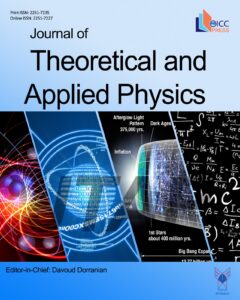Time-dependent one-dimensional simulation of atmospheric dielectric barrier discharge in N2/O2/H2O using COMSOL Multiphysics
Authors
Abstract
AbstractThe results of time-dependent one-dimensional modelling of a dielectric barrier discharge (DBD) in a nitrogen–oxygen–water vapor mixture at atmospheric pressure are presented. The voltage–current characteristics curves and the production of active species are studied. The discharge is driven by a sinusoidal alternating high voltage–power supply at 30 kV with frequency of 27 kHz. The electrodes and the dielectric are assumed to be copper and quartz, respectively. The current discharge consists of an electrical breakdown that occurs in each half-period. A detailed description of the electron attachment and detachment processes, surface charge accumulation, charged species recombination, conversion of negative and positive ions, ion production and losses, excitations and dissociations of molecules are taken into account. Time-dependent one-dimensional electron density, electric field, electric potential, electron temperature, densities of reactive oxygen species (ROS) and reactive nitrogen species (RNS) such as: O, O−, O+, O2-documentclass[12pt]{minimal} usepackage{amsmath} usepackage{wasysym} usepackage{amsfonts} usepackage{amssymb} usepackage{amsbsy} usepackage{mathrsfs} usepackage{upgreek} setlength{oddsidemargin}{-69pt} egin{document}$$ { ext{O}}_{2}^{ – } $$end{document}, O2+documentclass[12pt]{minimal} usepackage{amsmath} usepackage{wasysym} usepackage{amsfonts} usepackage{amssymb} usepackage{amsbsy} usepackage{mathrsfs} usepackage{upgreek} setlength{oddsidemargin}{-69pt} egin{document}$$ { ext{O}}_{2}^{ + } $$end{document}, O3, N,N2+documentclass[12pt]{minimal} usepackage{amsmath} usepackage{wasysym} usepackage{amsfonts} usepackage{amssymb} usepackage{amsbsy} usepackage{mathrsfs} usepackage{upgreek} setlength{oddsidemargin}{-69pt} egin{document}$$ { ext{N}}, { ext{N}}_{2}^{ + } $$end{document}, N2s and N2-documentclass[12pt]{minimal} usepackage{amsmath} usepackage{wasysym} usepackage{amsfonts} usepackage{amssymb} usepackage{amsbsy} usepackage{mathrsfs} usepackage{upgreek} setlength{oddsidemargin}{-69pt} egin{document}$$ { ext{N}}_{2}^{ – } $$end{document} are simulated versus time across the gas gap. The results of this work could be used in plasma-based pollutant degradation devices.



